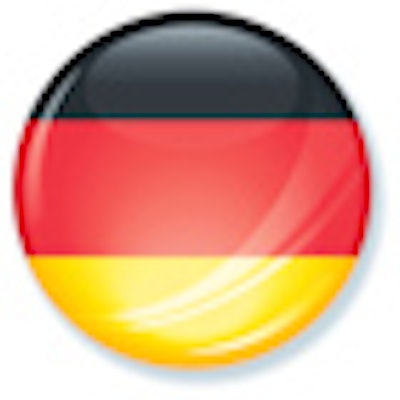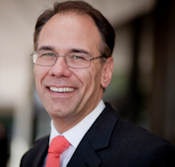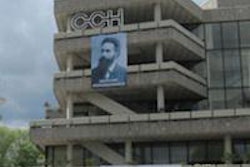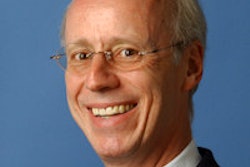
The German Radiological Society's annual meeting, the DRK, starts in Hamburg tomorrow. Congress president Dr. Hermann Helmberger from Munich plans to "link contradictions" by crossing subjects that within themselves contain a huge variety of different and at times conflicting interests.
"Our focus will be on the common interests of working groups that combine for example, diagnostic cardiovascular imaging and therapeutic interventional radiology," he noted in an interview with AuntMinnieEurope.com. "Through combining interests we can learn about the goals of both diagnostic and therapeutic radiology, and the prerequisites to achieve them."
 A balance of generalist and subspecialist radiologists needs to be achieved to assure a bright future for German radiology and keep in step with clinicians, according to Dr. Hermann Helmberger.
A balance of generalist and subspecialist radiologists needs to be achieved to assure a bright future for German radiology and keep in step with clinicians, according to Dr. Hermann Helmberger.
The central themes this week in Hamburg include abdominal imaging under the umbrella of which oncologic imaging will be juxtaposed with developments in intervention. Other overlapping sessions include adult and pediatric rheumatoid arthritis imaging, uroradiology in adults and children, as well as sessions on hybrid modalities such as PET/CT, PET/MR and SPECT/CT.
The combined sessions not only pertain to the radiological community, but will also extend to nonradiological specialists such as nuclear medicine physicians who will deliver lectures alongside general radiologists and subspecialists such as pediatric radiologists. The topics of these sessions will be advances in PET/MR, the current status of cardiac imaging, and rheumatoid arthritis imaging in children.
These common sessions are a new phenomenon at DRK, and will be complemented by a third axis, the use of mixed discipline panels during the lectures, according to Helmberger, who is head of radiology and nuclear medicine at the 800-bed Catholic hospital Klinikum Dritten Orden (KDO) and who is involved in vascular interventions and abdominal imaging in oncology patients.
The mixed panels will include representatives from eight other medical societies who will bring discussion of the clinical issues and considerations to the same table. One such session on pancreatic carcinoma will involve a panel of radiologists, gastroenterologists, and abdominal surgeons. Another will debate the best ways for treating peripheral vascular disease with the input of angiologists, vascular surgeons, and radiologists.
Also new to DRK this year is the format of the highlighted sessions, which this year take place over Thursday, Friday, and Saturday and will each focus on one special topic. These sessions will be led by an honorary member of the DRK who will be supported by other speakers providing delegates with the opportunity to learn about a specific aspect of diagnostic radiology that will include for example uroradiology with a focus on prostate cancer. In another highlighted session, the current status of IT in clinical practice will be discussed, while the third session will cover whole-body imaging including hybrid techniques such as PET/CT.
In some ways, these special focus sessions reflect one of the challenges facing radiology today in Germany, Helmberger noted.
"There is an increase of subspecialties in all clinical areas, and the need for certification of centers of excellence in for example, cardiology, breast, and neurology. This means there is a need for many subspecialists in the bigger or specialized centers and on tumor boards, which must be balanced with enough generalists working in the smaller hospitals," he explained, adding that in Germany the structures remain similar in most hospitals, with one head, a few consultants, and then a number of assistant radiologists.
KDO may be an exception to the rule due to a team of specialists with wide general training: Outpatient throughput at the relatively small three-site center is estimated at around 40,000 per year. The radiology department, an industry "center of reference" and a veteran PACS user for the past 10 years, comprises 60 staff, including 16 radiologists and 35 technicians. These staff operate a fully-equipped unit which, unusual for a "small Catholic hospital," ranks 13th in Germany for offering patients PET/CT and yearly undertakes 600 PET/CT, 3,500 MRI, 8,000 CT, 6,500 ultrasound, 80,000 mammography and conventional x-ray, and 500 interventional vascular procedures.
"The existing structure of radiological organization that exists in Germany today needs to be altered if radiologists want to remain competent partners with their clinical colleagues," he continued. "I am optimistic about the future of radiology in Germany provided this issue of organization can be solved and a good working relationship between both subspecialists and generalists can be established."
Compounding this problem is the decreasing number of German medical students who are opting to work as medical doctors after they finish their studies, choosing instead to take positions as industry consultants or in other nonclinical sectors. The knock-on effect is fewer entries into radiology and to counter this, the DRK has launched a campaign to attract medical students into the specialty.
The "Best People for Radiology" campaign is already making its presence felt through e-media promotion and in university hospitals with students able to access the society's educational programs from their own laptops or at public events.
"The aim is to show students the attractions of being a radiologist in Germany today," Helmberger said.
Last year's DRK, held jointly with that of the Austrian Society of Radiology, attracted 7,000 delegates. This year's conference is solely a DRK event, and appears likely to attract similar figures, which would imply a slight rise in delegate numbers, say conference organizers. Technicians and radiologists make up the majority of the delegates -- the technicians forming a large minority of around 2,000, with several hundred industry representatives forming a smaller group of attendees.
Given the size of the congress center, Hamburg is unlikely to see the total number of delegates swell further. Given the legal obligation on German doctors to earn points through ongoing education, the conference is not likely to experience a downturn in numbers either, despite the current economic climate where department budgets for such education are seriously pressurized.
Hamburg will serve as the host city for the DRK for at least the next three years. The location of the congress center makes access to and from hotels and attractions a unique advantage, despite the more comprehensive transport systems of Berlin and Frankfurt, Helmberger said.
This year, one of the highlighted sessions on uroradiology will be held in English. An honorary DRK member from Japan will give the main lecture of the uroradiology session in English. The organizers hope the number of overseas speakers will grow in the future, leading to more English-language sessions and opening up the conference to international delegates. However, the congress will remain quintessentially German and is not meant to be seen as a smaller rival to ECR, he concluded.



















